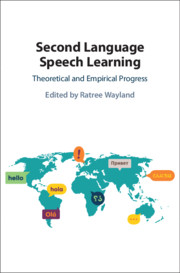Book contents
- Second Language Speech Learning
- Second Language Speech Learning
- Copyright page
- Dedication
- Contents
- Figures
- Tables
- Contributors
- Preface
- Acknowledgments
- Part I Theoretical Progress
- Part II Segmental Acquisition
- Part III Acquiring Suprasegmental Features
- Chapter 9 Relating Production and Perception of L2 Tone
- Chapter 10 Production of Mandarin Tones by L1-Spanish Early Learners in a Classroom Setting
- Chapter 11 Production of English Lexical Stress by Arabic Speakers
- Chapter 12 Variability in Speaking Rate of Native and Nonnative Speech
- Part IV Accentedness and Acoustic Features
- Part V Cognitive and Psychological Variables
- Index
- References
Chapter 12 - Variability in Speaking Rate of Native and Nonnative Speech
from Part III - Acquiring Suprasegmental Features
Published online by Cambridge University Press: 21 January 2021
- Second Language Speech Learning
- Second Language Speech Learning
- Copyright page
- Dedication
- Contents
- Figures
- Tables
- Contributors
- Preface
- Acknowledgments
- Part I Theoretical Progress
- Part II Segmental Acquisition
- Part III Acquiring Suprasegmental Features
- Chapter 9 Relating Production and Perception of L2 Tone
- Chapter 10 Production of Mandarin Tones by L1-Spanish Early Learners in a Classroom Setting
- Chapter 11 Production of English Lexical Stress by Arabic Speakers
- Chapter 12 Variability in Speaking Rate of Native and Nonnative Speech
- Part IV Accentedness and Acoustic Features
- Part V Cognitive and Psychological Variables
- Index
- References
Summary
The bulk of the work on non-native speech has focused on average differences between L1 and L2 speakers. However, there is growing evidence that variability also plays an important role in distinguishing L1 from L2 speech. While some studies have demonstrated greater variability for non-native than native speech (e.g., Baese-Berk & Morrill, 2015; Wade et al., 2007), others have demonstrated that under some circumstances non-native speech maybe less variable and that variability in non-native speech may shift as a function of many factors, including task (Baese-Berk & Morrill, to appear; Baese-Berk, Morrill, & Bradlow, 2016) and L1-L2 pairing (Vaughn, Baese-Berk, & Idemaru, to appear). In the present study, we ask how variability manifests in L1 and L2 speech by speakers from a variety of language backgrounds. Specifically, we ask whether a speaker whose L1 speaking rate is highly variable is also highly variable in their L2. We also ask whether variability in speaking rate in L1 or L2 differs as a function of task (e.g., read vs. spontaneous speech) and complexity of the task (e.g., more or less complicated reading passages). The results of this study will inform our understanding of the myriad complex factors that influence non-native speech.
- Type
- Chapter
- Information
- Second Language Speech LearningTheoretical and Empirical Progress, pp. 312 - 334Publisher: Cambridge University PressPrint publication year: 2021
References
- 1
- Cited by

